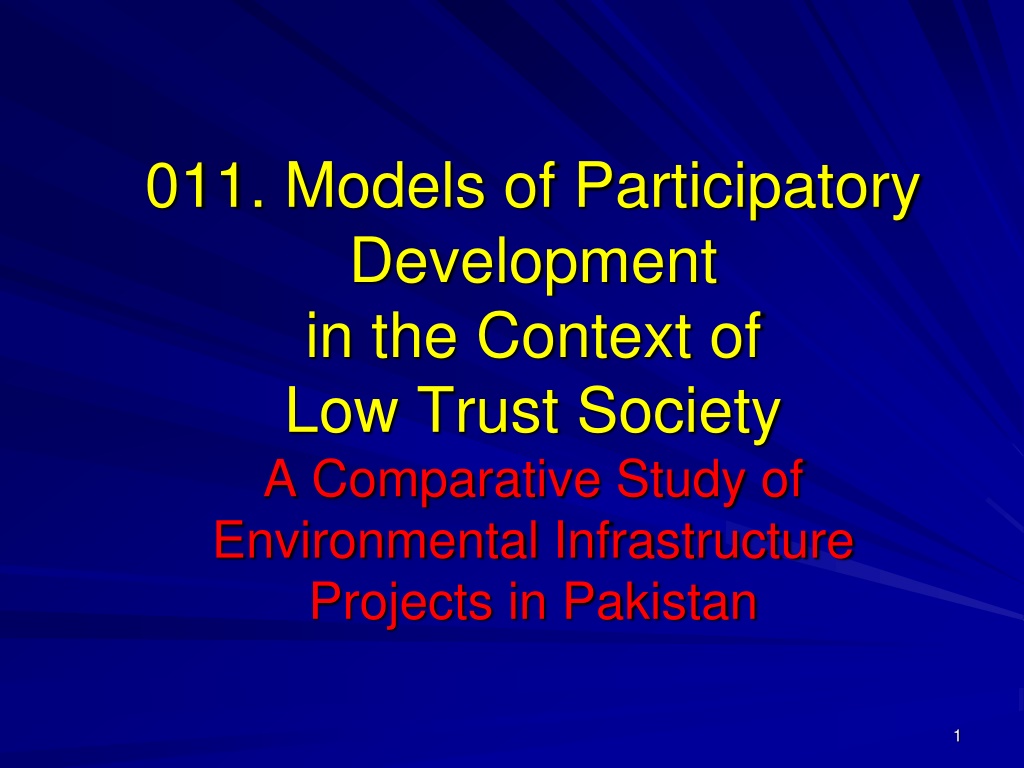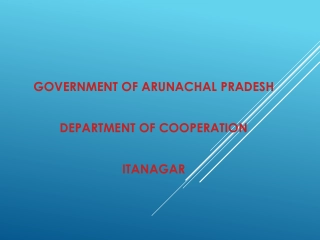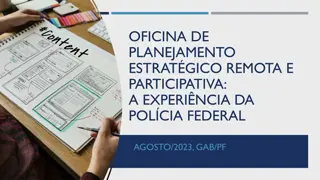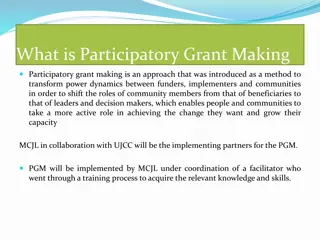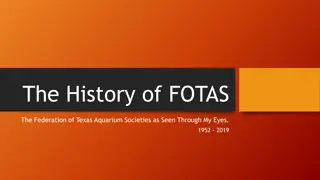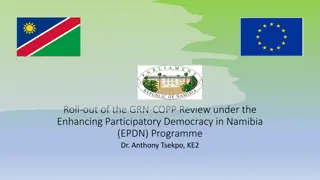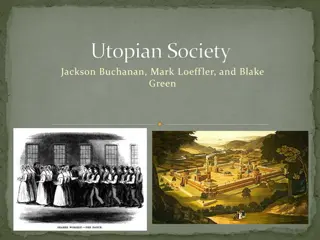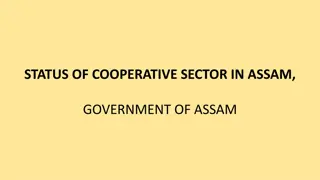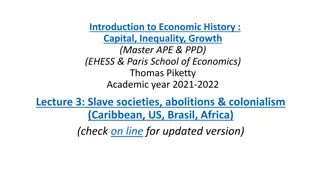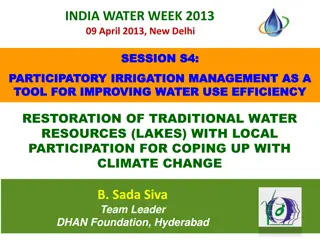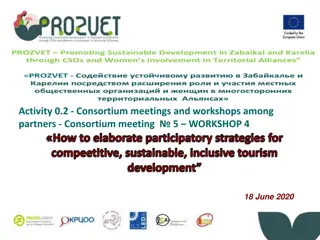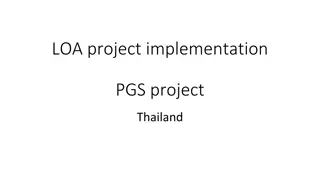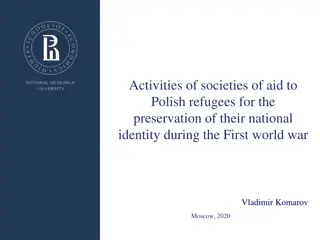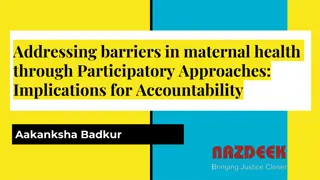Participatory Development and Trust Building in Low-Trust Societies
Models of participatory development in low-trust societies highlight the failure of government-led approaches due to inequalities and distrust between government agencies and communities. Breaking this vicious circle requires establishing equitable partnerships and ensuring equal roles in planning and decision-making to foster trust and social capital for mutual cooperation.
Download Presentation

Please find below an Image/Link to download the presentation.
The content on the website is provided AS IS for your information and personal use only. It may not be sold, licensed, or shared on other websites without obtaining consent from the author. Download presentation by click this link. If you encounter any issues during the download, it is possible that the publisher has removed the file from their server.
E N D
Presentation Transcript
011. Models of Participatory Development in the Context of Low Trust Society A Comparative Study of Environmental Infrastructure Projects in Pakistan 1
Breaking the Vicious Circle of Distrust and Underdevelopment It is generally realized by development planners that in low trust society the government-led approaches of participatory development fail because the beneficiary communities are not given their justified role in the process of planning and decision making. These inequalities and asymmetries devastate social trust and give rise to the accumulation of distrust between government agencies and communities. As a result, the vicious circle of trust and development appears. 2
This vicious circle of distrust gets stronger due to centralized bureaucratic system of government because central control of resource allocation brutalizes social relations and gives rise to widespread corruption in the society. In government-led approaches of participatory development, the government agencies retain the right to exit from the project in their hands while communities are expected to extend volunteer cooperation. Particularly, when government agencies exit from the project without completion communities helpless and complainant, the vicious circle of trust and development is further strengthened. by leaving 3
Cooperation needs trust and trust generates atmosphere for mutual cooperation. In order to establish a trustworthy working relation between government agencies and the community, it is necessary to break this vicious circle. This vicious circle can be broken if communities at grassroots level are given equal share in the role, power, information and decision making in the process of planning and development by establishing equitable partnerships through legal contracts. Institutional framework of equitable partnerships can convert vicious circle into opportunities of self-reinforcing and cumulative stock of social capital, trust, norms and social networks. 4
Relationship of Trust, Social Capital and Volunteer Cooperation Social Capital is the ability of people to work together for common purpose and organization. [1] Like other forms of capital, social capital is productive, making possible the achievement of certain ends that would not be attainable in its absence. [1] Social capital is a public good, unlike conventional capital, social capital is not the private property of any of the persons who benefits from it. [1] [1] James S. Coleman (1990) Foundation of Social Theory. Cambridge, Mass.: Harvard University Press) p. 302, -.204, p.307. 5
Trust is an essential component of Social Capital and it is a moral resource. Its supply increases rather than decreases through use and it become depleted if not used. [1] Social capital, unlike other forms of capital, must often be produced as a by-product of other social activities. [2] The more two people display trust towards one another, the greater their mutual confidence.[2] [1] James Coleman, 1988, see in Fukuyama (1995), p.10] [2] Putnam Robert D. (1993) Making Democracy Work: Civic Traditions in Modern Italy. Princeton University Press. Page 170 6
Trust cooperation generates trust in turn. [1] Ostrom (1990), giving example of CPR, concludes: When individuals have lived in such situations for a substantial time and have developed shared norms and patterns of reciprocity, they possess social capital with which they can build institutional arrangements for resolving CPR dilemmas. [2] A. O. Hirschman, Against Parsimony: Three Easy Ways of Complicating Some Categories of Economic Discourse, American Economic Review Proceedings 74 (1984): 93, as cited in Partha Dasgupta, Trust as a Commodity, in Trust, ed. Gambetta, p.56. (Mentioned in Putnam 1993, p. 169) [2] Elinor Ostrom (1990) Governing the Commons: The Evolution of Institutions for Collective Actions. New York: Cambridge University Press. Page 183-184. (Mentioned in Putnam 1993, p. 169) lubricates cooperation and [1] 7
Failure of Government Led Models of Participation in Developing Countries In perspective of third world countries (Indo-Pak subcontinent), David C. Korten (1986) [1] classifies the government-led approaches of participatory development into three types: 1. Community Development (1950-mid 60 s) 2. Popular Participation (1960 s 1970 s) 3. Decentralization ( 1980 s ~ ) [1] Korten, D. C. (1986) Community Management: Asian Experience and Perspectives. Kumarian Press. p. 8-10 8
Community Development (1950 mid to 60 s) Government-Led programs development largely failed because: Program were formulated centrally Implemented through conventional bureaucratic structures Little regard to the willingness or capability of the people. Little effort was independent, member-controlled organizations which can be able to solve local problems, mobilize local resources. of community devoted to building local 9
Popular Participation (1960 s to early 1970 s) In participation was heavily stressed but in reality meaningful participation was largely precluded by the planning procedures. The key decisions for projects were all centrally determined by planning experts. These experts had neither the incentive nor the means to obtain meaningful inputs from unorganized, poorly educated, and widely dispersed beneficiaries to the design of multi- million dollar projects. programs the importance of popular 10
Once such plans were completed and accepted, the only avenue left for beneficiary communities was to provide volunteer cooperation to implement decisions in which they had no part. Furthermore, these plans were implemented through centralized, hierarchical, rule-bound development agencies. And there was little or no accountability to the people who had a direct interest in actual outcomes. 11
Decentralization (1980 s ~ onward) In this approach, the administrative functions are decentralized to implement the national programs through local administrative units. The local administrative units are accountable to local political structures for responsive decision making. The role and power of decision making was in the hands of government agencies while communities were used as tool to implement agenda of central government or donor agencies. As an outcome these approaches strengthened the vicious circle of distrust. 12
Vicious Circle of Trust and Development Government-Led Community Participation (Centralized approach, Inappropriate Rules , donor driven) Low Trust Society Declined Social Capital and reduced volunteer cooperation Unequal Participation Government: Right to Exit Communities: Volunteer/ Asymmetries of role, power, Risk, Capital FAILURE Inappropriate goal setting Inefficient use of resources Corruption 13
The vicious circle of trust and development is strengthened due to centralized systems of governance and inappropriate rules in the government led community participation. approaches of These unequal in nature because at one side communities are expected to extend volunteer cooperation while on the other side the government agencies retain the right to exit from the project at any stage without its completion. participation approaches are 14
Due to asymmetries of the role, power, risk and resource allocation and its utilization, these unequal partnerships fail to generate trustworthy relationship between communities and government agencies. Moreover due to the inappropriate goal setting without considering the priority needs of beneficiary communities, the real problems of communities are usually not addressed properly. On the part of government agencies, absence of legislative corruption and inefficient utilization of financial resources results in widespread distrust in the communities. working accountability, 15
What is Low Trust Society? Trust Cooperative behavior based on commonly shared norms in a community (Fukuyama, 1995) Norms of Reciprocity & network of civic engagements are two sources of generating social trust (Putnam, 1993) High Trust Society (Developed Nations) Substantial Stock of Social Capital, High volunteer cooperation, Social networks Low Trust Society (Developing Nations) Low Stock of Social Capital, Widespread distrust in society social capital: the ability of people to work together for common purpose in groups and organizations (James S. Coleman, 1988. See in Fukuyama (1995) p. 10 ) 16
Putnam and Fukuyama assumes that institutions easily flourish in high trust society because of high stock of accumulated social capital. But Low Trust Society can never escape out of the vicious circle of distrust because of low stock of social capital which diminishes with disuse. This means the gap between high and low trust society will continue to widen in development context. But we see that many communities in low trust societies have demonstrated best practices for cooperative actions. That means the division of high trust and low trust societies is not appropriate. Within the low trust society, high level of trust exists. We need to redefine trust situation. 17
Social Trust in Development Process Extended Trust Low High Limits of self-organized communities: Widespread Distrust, weak norms, Dishonesty, Less Social Capital, Low potential of self organization Scale of collaboration Low Public-Private Partnerships (Asymmetric relationship between govt. and communities). Internal Trust Needs bondage of contracts High cooperation, High volunteerism, Ready to cooperate without contracts, Enriched Social Capital and Trust. Self Organized Community: High Within the community there is high volunteer cooperation and social networks. 18
Within the low trust society, social trust is divided into internaltrust and extendedtrust . Stock of social capital in internaltrust provides base for extended trust. Every society possesses traditionally some stock of social capital with varying degree of social trust. Their level of extended trust depends on the role, power, share in information, capital, and risks; given to them by the government agencies. The extended trust ends in distrust when government fails to fulfill its promised If institutional framework guarantees to eliminate the asymmetries and inequalities of partnerships, it can generate social trust with high level of extended trust. 20
